MONKEY BUSINESS
The move to Uvongo was accomplished without the stress which had accompanied the event-filled move to Hermannsburg from Iswepe (see Moving On).
Acclimatising to life on the Kwazulu-Natal South Coast, however, had its own challenges. It is one thing to spend holidays here in mostly clement weather, and quite another thing to experience day to day living in a subtropical climate when you are accustomed to inland conditions.
We arrived in the spring, only to discover that, far from the warm, often windless weather we had experienced during our autumn and winter holidays, it was now surprisingly cold and the wind was relentless. We were, however, given the comforting information that spring on the South Coast is actually the most unpleasant time of the year, and locals often have the sense to take their holidays elsewhere, in more salubrious climes, during this season.
Hanging up the washing in spring (and sometimes in the summer) is interesting.
Besides the fact that the wind makes determined efforts to wrest the washing from your hands, the washing flaps so violently as you hang it up that the various articles become thoroughly tangled together. And it is not unknown to receive a heavy slap across the face from a wet towel. Once you have hung it all up, you retire to the kitchen with shaking knees and quivering arms, and from there you can observe the rotary line spinning like a top. I would not be surprised to see the whole thing launch itself into the sky and disappear over the neighbour’s roof!
But by the end of our first summer, I had discovered that the winds are also a blessing. The intense summer heat and humidity would be unbearable if it weren’t for the relief provided by the prevailing winds. So, on windy washdays, I gird my loins with my tie-on peg bag, roll up my sleeves, and prepare to battle with the elements – with exclamations, but no complaints.
But, oh, my, how wonderful are the autumns and winters! Days on end of soothing warmth, cloudless skies and gentle breezes, like perfect pearls strung on a chain of gold. Then we realise afresh why we moved here!
It was not long after our move that Pixie demonstrated that the survival of the Hermannsburg gosling (see Goose Wars) had not been a lucky accident.
The street we stay in forms a horseshoe with a second road, and this horseshoe surrounds the top of a hill. The inner area is a vacant lot. It is not very large, is quite flat and is very overgrown with wild banana trees, milkwood and quite a few exotic shrubs which have obviously been discarded over the fences of the homes enclosing the lot.
Our house is one of these and we have access to the lot via a rather rickety gate, which does, at least, prevent the dogs from getting in there. However, some of these trees grow through the fence into our yard, one of them providing marvellous access to the lot for any tree climbing dachshund (see Idyll), but more about that further on. We never gave a thought to the fact that it might also provide entry into our garden.
One morning I was in the kitchen when I heard a shriek of horror from Tasha’s flat, which is situated between the house and the vacant lot. Glancing quickly through the kitchen window, I was in time to see Pixie emerging from behind the flat, triumphantly carrying a dassie (hyrax, for those of you who are not South Africans), which hung limply from her jaws. It was a very large dassie, and Pixie’s head was lifted high, like a leopard carrying a small buck. She had it by the throat and the poor thing’s eyes were bulging and its tongue was protruding.
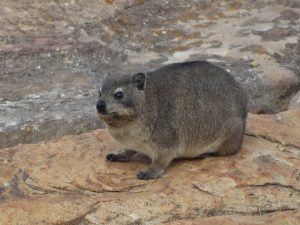
A Manaba Dassie
Hastily I opened the kitchen window and firmly commanded Pixie to drop it. Thanks to Tasha’s training, she did. She bounded happily up to the kitchen door leaving the limp body on the lawn. As I went out through the door, with the intention of retrieving the corpse, the dassie came back to life. It looked around in bewilderment and then scampered off, and finding a gap between the wall and the floor of the rather make-shift toolshed next to the flat, it took refuge in there.
We closed the dogs into the kitchen and then Barry and Tasha cautiously opened the door into the toolshed. They found the cowering dassie and ushered it out. It took the hint and streaked out with surprising speed. They tried to follow it to see where it went, but it had disappeared. As it first had to climb a fairly high retaining wall immediately behind the flat to get to the fence, we can only assume that dassies are greased lightning when they run for their lives.
It was while we were looking for a possible entry point into our garden from the lot, that we first noticed the tree mentioned above, and concluded that this must have been the route the dassie used.
We never saw it again, and even though we have since been onto the lot at the back, we saw no signs of any dassie colony.
A small rocky ravine which opens into the Vungu River is just a block away from us, and possibly it came from there, but why it would have traversed one busy road and two others, and then crossed one of the gardens adjoining the lot, remains yet another unsolved mystery.
Another big difference down here on the Hibiscus Coast (Hibberdene to Port Edward) is the soil.
In the Greater Escarpment area and upper Midlands, where we had spent much of our married life, there are mostly clay-based soils. These tend to be almost iron hard when dry and are therefore resistant to moles. Here, on the coast, on the other hand, the soil is very sandy and the moles thrive.
Soon Pixie and Bessie were frantically digging, and their excavations sank deeper and deeper until it seemed they were determined to mine down to the core of the earth. It would not be too long before Pixie emerged triumphantly with a mole.
We stopped counting after the twenty-third mole.
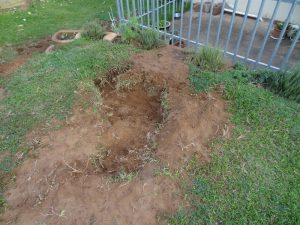
No words necessary
But it was only when we started gardening that we realised we had a serious problem. It is extremely exasperating when you have, at some expense, laid down an area of instant lawn, only to find it reduced to scattered tufts by maddened dogs. Equally annoying is finding evenly raked beds churned up and newly planted seedlings flung to the far corners of the garden.
I googled the problem and made a surprising discovery.
In South Africa there are two kinds of moles, and neither of them is, in fact, a mole!
The one kind is a mole-rat, which is a rodent (as are true moles), with the typical long incisors, and it lives on roots. It digs very deep tunnels and consequently creates large mole hills. This is the one which can cause major damage to plants in the garden.
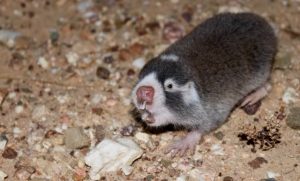
A Cape Mole Rat –
image from the public domain.
The other is known as a golden mole, and is not even a rodent. It does not have the long incisors and, because it is carnivorous, it is actually a gardener’s friend. It doesn’t touch your plants but feeds on bugs and harmful caterpillars. It also forages just under the surface of the ground and its route can be seen as raised tunnels winding about your flower beds. Its living quarters are not as far underground, so the mole heaps it creates are not as large as that of the mole rat. It’s forefeet are also completely different as can be seen in the photos below. Instead of individual toes, it has a single digging “claw” beautifully created for the purpose. Another difference is that while the mole rat has eyes, the golden mole only has rudimentary eyes and is completely blind.
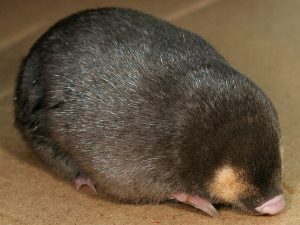
A Cape Golden Mole – image from the public domain.
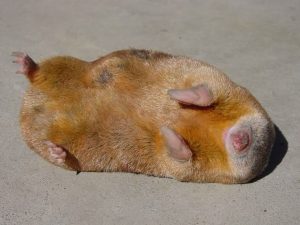
From the public domain – clear image of digging claws and golden coat.
This discovery was a big relief to me. I had noticed the raised tunnels and had feared for my plants. I was quite happy to live and let live. In fact, I find them to be really cute.
Unfortunately, the dogs do not share my philosophy and they have one thought – it must die!
As the years have passed, the numbers of moles in our garden have dwindled, but every now and again we have to sorrowfully dispose of a little corpse – every one of which has been a golden mole – and then refill holes and replant grass and flowers.
I have reached the sad conclusion that owning dogs and serious gardening are mutually exclusive occupations.
This brings me to the monkey menace.
The only true monkey in South Africa is the Cape Vervet and it is found wherever there are forests, both plantation or indigenous, so we were already very familiar with them. They had not bothered us much in Iswepe and Hermannsburg but here in Uvongo there is one particular troop which considers the vacant lot behind us to be part of its foraging territory.
Two or three times a week they wend their way towards us using one of two routes.
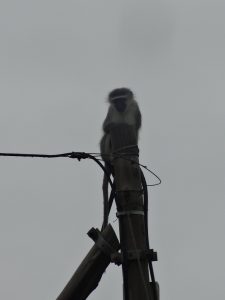
Monkey on the powerline pole
Route A is via an unknown (to us) way onto the vacant lot which leads them along the power line strung up above the back fence. Here milkwoods and palm trees provide excellent vantage points from which to taunt the dogs. (As an aside, in winter they also gorge themselves on the flowers of the golden shower growing along the fence and into the trees.)
Route B is from the street in front of the house. They ascend the front wall via the tibouchina trees growing on the pavement in front of our property, and then they run along the side walls to get to the wild banana trees at the back, from which they gain access to the power line.
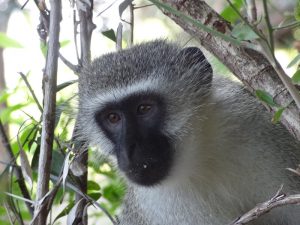
Vervet Monkey in the Kruger Park
The use of either route causes havoc because the dogs go ballistic, trampling my plants (with Pixie even injuring herself) as they leap upwards. Everything growing near the wall is in grave danger of being trampled flat. (Goodbye, my six beautiful plectranthus shrubs… It was nice knowing you… Farewell, O wild pomegranate… You didn’t stand a chance…) I won’t list them all. You get my drift, I’m sure.
While Tilly left the golden mole extermination programme to Pixie and Bessie, she wholeheartedly endorsed the campaign to rid the world of monkeys.
After one of these attempted assaults, we noticed that Tilly had disappeared. Terrified that she had perhaps been grabbed and carried off by one of the adult monkeys, we called for her quite frantically and eventually discovered that she was outside on the lot! We had to unlock the gate for her and were quite perplexed as to how she had got there. The next time the monkeys paid a visit, we saw what she was doing. She had found the Tilly-tree.
But besides the monkeys, Tilly had also discovered that there was… wait for it… yes, an evil Tilly-bird, which haunted the trees on the lot! (See Idyll.)
This increased the danger because, whereas when the monkeys arrived, the noise Pix and Bess made alerted us and we were able to confine them to the kitchen until the danger had passed, the Tilly-bird hunts were conducted in stealthy silence, so we only realised that Tilly was up the tree when we noticed that she was missing.
After Tasha had rescued her from the tree a few times, Barry rigged up a barricade. The distance to the ground was quite high and we were concerned that she would, sooner or later, break bones.

Rescuing Tilly from the Tilly-tree

Tilly, keeping a sharp lookout for the Tilly-bird
One day, when taking a closer look at the overgrown vegetation at the back fence, my blood ran cold. For the first time I noticed that there was a roll of barbed wire as well as one of razor wire all along the top of the fence! If we did not prevent Tilly from climbing, it was just a matter of time before she fell onto the wire and ripped herself to shreds.
And, indeed, it was not long before she got over the barricade and when we found her on the lot she had a small but rather nasty snag on her side. She did not need stitches, but it left an unsightly v-shaped scar.
Cutting the tree down would be very difficult. Not only is the wood exceptionally hard, but the shape of the trunk and the way it has grown through the fence would result in the destruction of the fence, if we chopped it down. And replacing the fence was a project we were unwilling to undertake at the time.
Yet more work was done on the barricade, which was by now becoming a bit of an eyesore, to say the least.
Tilly’s scar had scarcely healed when our worst fears were realised. Some of the branches had grown through the razor wire and Tilly got hooked up on it. She could move neither backwards nor forwards without severely tearing her flesh as one of the hooks was deeply embedded. Mercifully, Barry was at hand, because Tasha’s arms were not long enough to reach her. He had to unhook her from the razor wire and then I had to rush her off to the vet. It took two stitches to close the deep gash.
By the time I arrived home with the silly dog, the barricade had reached hideous proportions, but we were at least positive that she would not be able to get round, over or past it, unless she actually sprouted wings and flew over.
Then fate intervened…
Submit your review | |
1 2 3 4 5 | |
Submit Cancel | |